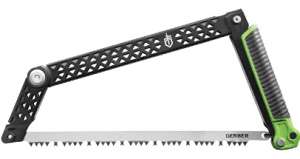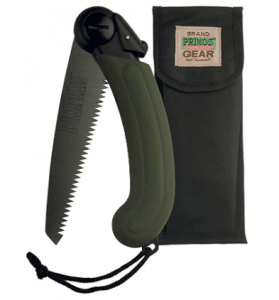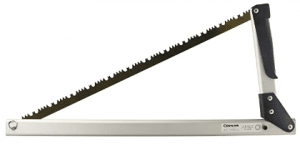Whether you are looking for gear for gardening, hiking, or surviving, a pocket folding saw is a bliss! You will use it for pruning in the garden or while clearing the path in the wilds. In our article, you will learn which features are crucial while choosing this tool as we reveal the secrets of carbon and steel blade types, discuss the best handle and sheath designs, and review the top-notch brands. This hand saw is bushcraft, and you are welcome to learn more from our article!
Can you name several critical survivalists’ tools on top of your head? In our opinion, there are at a minimum five cutting tools every self-respecting prepper should own:
- Survival Knife
- Survival Hatchet
- Survival Ax
- Survival Machete
- Folding Saw.
And while many people pay more attention to hatchets and axes, probably because they are both self-defense weapons and cutting tools, the folding saw’s capacities and function are often left unjustly understated. But a folding saw itself deserves a thorough and detailed review as this compact and lightweight tool often turns out to be more useful.
So, today we are going to tip the balance back and explain why folding saws are very much desired and specifically cover the topics of what a folding saw is, why it is worth investing in, how to treat and sharpen it, the key features to seek in such a saw, and the concise review of the best folding saw items on the market.
Delve into the prepping guide we made for all you keen preppers out there. Our blog proposes extensive information about the first-rate survival gear , survival skills to notice, and true facts homesteaders and prepping fans!
TOP 10 Best Worthy Folding Saws On Today’s Market
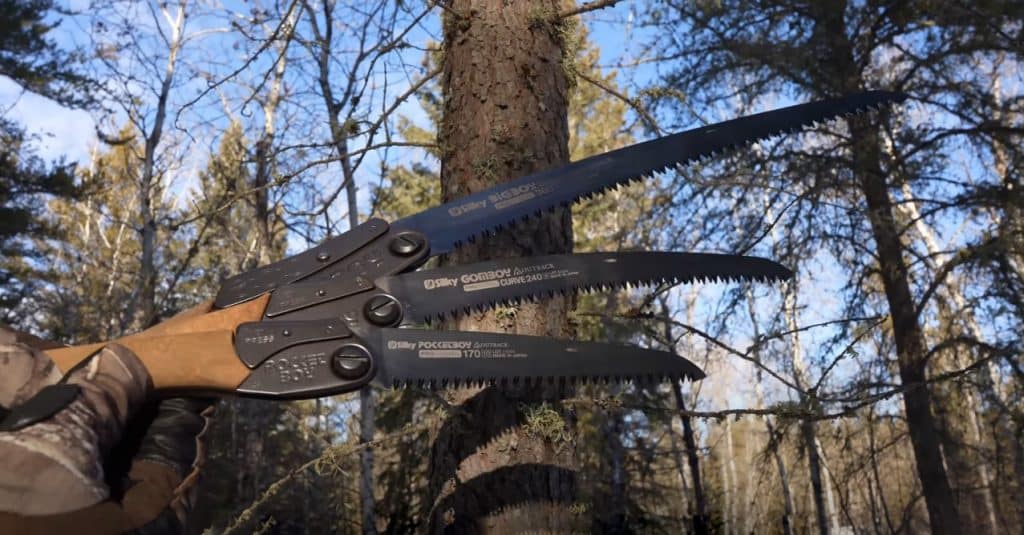
1 – Corona RazorTOOTH Folding Hand Saw
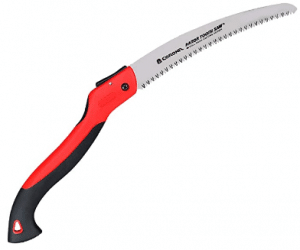
Ask almost any arborist pruning hundreds of trees weekly in gardens and parks — everyone must have heard of Corona Saws, and every other is likely using it in their work.
The Corona RazorTOOTH is a huge utensil with pyramidal teeth meant for efficient pruning on both strokes. It is convenient to use. It has a blade locking mechanism for two positions, a fine reach, and an ergonomic handle. Its blade is chrome plated and hardened though it requires some cleaning and a bit of oil coating to defer the distant future’s corrosion.
With a 10″ blade, it deals with the 6-inch branches easily, but for bigger chunks, we recommend buying a chainsaw.
The Corona Saw is competent, safe, and trusted by many arborists all over the world. What else could you wish for?
PROS
- Quality build and design
- If needed, blades can be replaced.
- Ergonomic handle for additional comfort
- Cutting action is clean and precise.
CONS
- Thinner cutting edges might bend if applied roughly or misused.
Buy the Corona 10″ Saw on Amazon and
Are you still pondering the pros and cons? Watch the video comparison between the Corona 10″ Razor Tooth Folding Saw, the Bahco Laplander, and The Silky Gomboy 210. A small spoiler: Corona will outpace in some features.
2 – Felco F 600 Folding Hand Saw
The Felco F600 is a nice little model best suitable for pruning and especially overhead use due to its lightweight, compactness, and easy-to-grip handle.
Apart from cutting fruit trees, this 6.3″ version of the folding saw will surely help with numerous yard works and camp chores.
It’s swift and effective, and the edge and tooth shape are designed so that it is easy to remove filings.
PROS
- Very compact and light
- Convenient handle that does not slip
- Cuts small and medium branches smoothly.
CONS
The design is probably too small for a big man’s hands though it fits women perfectly.
Watch a video review of this fine hiking and camping helper.
3 – Bahco 396-JT Folding Hand Saw
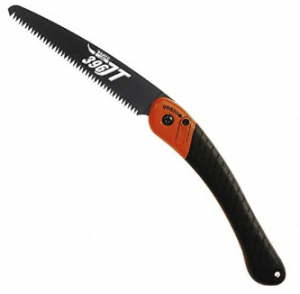
Another hand utensil deserving your attention is the Bahco 396-JT. It’s a quite popular model even among mountain bike trail-builders which means it has proven to be very resistant during tough mountain trail trekking. Firstly, it is light and rather small and cuts roots, twigs, and small fruit trees almost in two shakes. The non-stick blade covering is highly profitable in the wilderness as the inevitable sawdust, dirt, and sticky sap will not stick to it. Moreover, its replaceable blades are easy to change so, if you manage to bend it or drag its teeth across some random stone while trekking, you will not have to worry much.
PROS
- Sturdy blade lock working for both open and closed setups
- Changeable blades offer more flexible options.
- Its cutting edges have sap-proof covering with low friction.
CONS
- Its blade length is a little smaller than a standard one, so mind the branch size.
- It is designed dark-colored, so it may be hard to find in the bush.
Watch the video demonstration of how accurately Bahco Laplander saws and how strong it is regardless of its rather compact volumes.
4 – Silky Professional BIGBOY 2000 Folding Hand Saw
Silky is another well-known brand on our list of hand saws. And it is called “professional” for a solid reason — the BIGBOY 2000 justifies its name indeed firstly because it owns an impressive 14.2″ steel blade for the most challenging pruning chores. Thanks to its blade’s curved shape and effective design, it “grabs and bites” the trunks as big as 8-9″ and more. Secondly, its blade is replaceable, offering four edge designs (all interchangeable) that differ by their handle colors, all blades easy to mix and match right on one handle. And the color-coding facet allows you to seize the blade needed for your current purpose quickly. No matter how heavy and long-bladed this model seems, it’s surprisingly lightweight, weighing a bit more than 1 lb! Plus, it feels nice in the hands as it has a rubberized aluminum handle.
PROS
- Resilient build with a proven quality
- It weighs very little for its size.
- It has a longer blade than most of its similar-sized analogs
- Maintains balance when in action
CONS
- 16″ length in close position will not fit in every small backpack
- Quite costly
Watch the Silky Bigboy’s sharp blade tested in the outdoors.
5 – Gerber Freescape Camp Saw
The Gerber Freescape Camp Saw is distinguished from other models as it is a hand bow saw which means it folds down flat without removal of components and accepts the regular 12″ blade — the factors that make it very packable. Besides, it has a high carbon steel blade.
Apart from its compactness and small weight, it has a solid-looking aluminum handle and a rubber over-mold grip so that this rubber handle is harder to slip from your hands when at work accidentally.
PROS
- Interchangeable cutting edges
- Its die-cast aluminum handle can fold down, making it super compact for backpackers and trekkers.
- It has a relatively small weight.
CONS
- Bulkier logs are harder to cut with them due to their particular build.
Watch the video review and see how the Gerber Freescape Camp Model deals with bushcraft and other camping tasks like a true PRO.
6 – Fiskars 7″ PowerTooth Folding Hand Saw
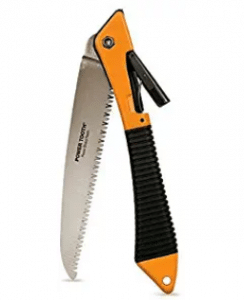
If you are even a little keen on cutting tools, you surely remember the Fiskars brand, the one that manufactures the well-known orange-colored scissors and hatchets — the company has a long backstory and worthy reputation. The 7″ PowerTooth pruning saw only proves it had an anti-slip handle fixing the locking blade right. The hardened blade has the so-called triple-ground teeth, so there are three cutting surfaces at each tooth. Such a design allows processing medium-sized branches and fuelwood swifter.
However, there is no sharpening device specifically for this saw’s tooth profile. Therefore it may be a troublesome action sharpening it yourself. In plus, its handle, though it seems thick and stable, is made of plastic, so it is better not to jeopardize this model by tough usage.
PROS
- Has a small weight
- Cuts quickly
CONS
- The plastic handgrip is more likely to break.
- When dealing with thick bulky logs, the blade may bind (due to its narrow kerf)
How much does it cost today?
7 – Primos Gear Folding Trail Saw
Even though many hands saw models are meant for tree surgeons, landscapers, and professionals, there are several decent backcountry saws for hunting and fishing available to everyone.
Primos Gear is mostly known as a proven hunting brand, and this model is not an exception. However, it can perform multiple tasks, including chopping firewood, daily camping duties, cutting fish, and so on. This fine saw is like a piranha: small and aggressive. It acts that sharply and rapidly due to its triangular-shaped teeth set.
The push-button blade lock allows the blade to stay protected. A small bonus for hunters: its dark-colored handgrip contributes to a hunter’s camouflage.
Be sure to have a suitable file to sharpen the blade and adjust it before using it for the first time.
PROS
- Ergonomic build
- “Camouflage-friendly” handle color
- Carrying bag included in the pack.
CONS
- It needs extra sharpening as it is not sharp right away.
8 – Silky KATANABOY Professional 500mm Folding Hand Saw
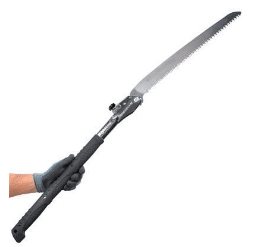
The Silky KATANABOY folding saw is your steel go-to samurai by definition. It means it is extremely sharp but does not fit in a regular-sized backpack. Anyway, it is indispensable on our list! Firstly, simply because it is the enormous professional folding saw one has ever seen. Its blade is a 19.7″ sharp edge reaching out the bulkiest and biggest limbs and logs. If you are car camping or on a car hunting trip, its size and blade length will never be a problem.
This samurai deserves not a standard belt sheath, but a big brand shoulder bag! In the domain where a chainsaw can hardly help, this Silky Katana Folding Saw is your optimal choice.
PROS
- Enormous reach
- Solidly built and made of proven quality materials.
- Cuts through all branches
- This saw comes with a fine shoulder bag.
CONS
- Too bulky to fit in a smaller-sized camping bag
- Predictably costly
Watch the video competition between Silky Katanaboy and the Bucksaw and see who owns a better razorblade.
9 – Silky POCKETBOY 340-13 Folding Hand Saw
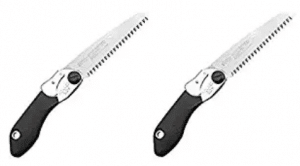
The Silky POCKETBOY boasts its quality material — 8.5TPI impulse-hardened steel and fine edgy teeth. Its blade is 5″ long and owns two lock mechanisms required for separate cutting positions and one for when it is folded down. Its material is pure artistry (as usual for Silky products) — a rust-resistant, hard chrome-plated, taper-ground blade plus impulse-hardened teeth, all made in Japan.
The teeth produce precise, flat, and razor-sharp cuts though they do not have a set. Hence, as the kerf is quite narrow, its user should stay attentive to potential blade binding.
PROS
- Pruning tiny limbs is absolutely effortless.
- A tough plastic belt case is included in the pack.
- Clean and even cuts due to its fine-tooth cutting edge
CONS
- It may feel too small in bigger hands.
- Bigger branches are harder to cut because of their teeth size.
Watch the benefits of the Silky Pocketboy 130 hand folding saw as compared to some other models and make your choice.
10 – Coghlan Folding Bow Saw
Here is the second example of a bow saw on our list, the Coghlan folding bow saw made in the United States. There are many oversized pocket knife-shaped folding saws available. Instead, this Coghlan model differs from them as it is a collapsible bow saw! Bow saws are solid helpers when chopping fuelwood and will less likely break down and bind. That is made possible due to its particular blade design acting under tension instead of compression.
The Coghlan is high quality, as usual, very light, easy to grip, and is probably the bulkiest logs cutter on our list.
Its only drawback is that it is hard to sharpen such blades at home, though they are sold at a budget-friendly price and are easy to change since almost every 21″ bow saw’ s blade would fit the Coghlan. Consequently, you may adjust several saw blade shapes to your current cutting purposes.
PROS
- Very lightweight item
- Its razorblade is simple to change.
- Its handgrip features several replacement blades.
CONS
- Blades may be too hard to sharpen at home.
Find out the actual price offer and further details on Amazon. (Buying through our site links, you support our modest work, and we may earn a small affiliate commission. Mind that the availability of products, the prices, and services may change).
What Is A Folding Saw Tool?
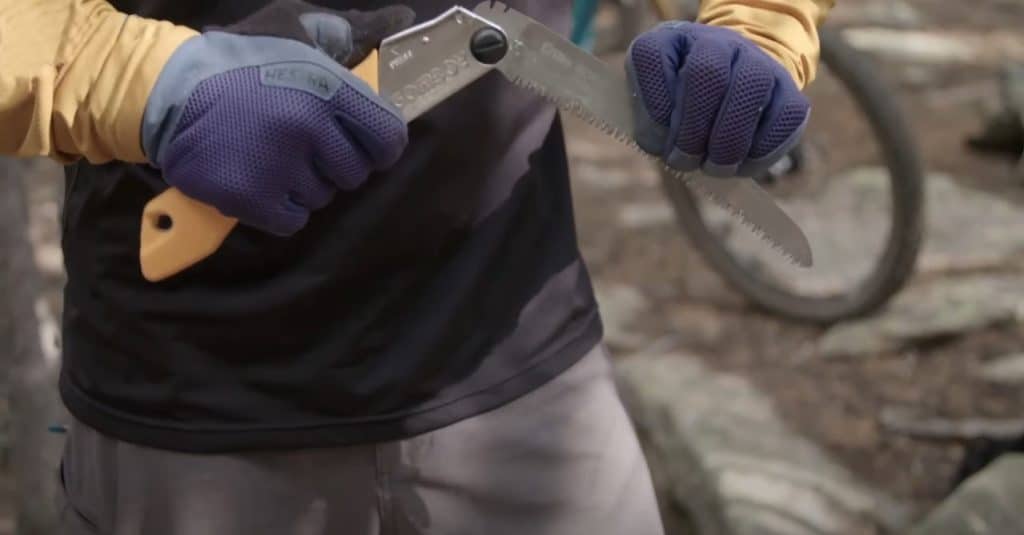
With the same key principle, there are various folding saw designs. The one you have surely come across is the saw with a blade the folds back into the handle, reminding of an enormous folding pocketknife.
This design is adaptable for both huge and small models and is easier to make, considered very simple yet reliable.
This principle may vary widely, and today there are more and more multi-purpose saws created to satisfy manifold demands.
- For instance, if you are keen on minimizing your overall backpack weight, there are ultra-lightweight models specifically for it.
- Besides, there are fine-toothed folding saws perfect for more meticulous works, such as pruning and cleaning gashes on live trees.
- Ice saws aimed at cutting through thick piles of ice and snow, especially in regions prone to avalanches.
- Tough survival saws for cutting fuelwood as if it was melting butter.
The key point here is since there is a folding saw for almost all occasions and some models own interchangeable adaptable blades with various tooth shapes, your privilege of choosing only one may turn into an issue.
Apparently, the ice-cutting saws work badly for cutting firewood but overtake the others when it comes to snow shelter building. Let’s examine why it is worth acquiring one and what model you should invest your budget in.
Why You Should Invest In A Pocket Folding Saw
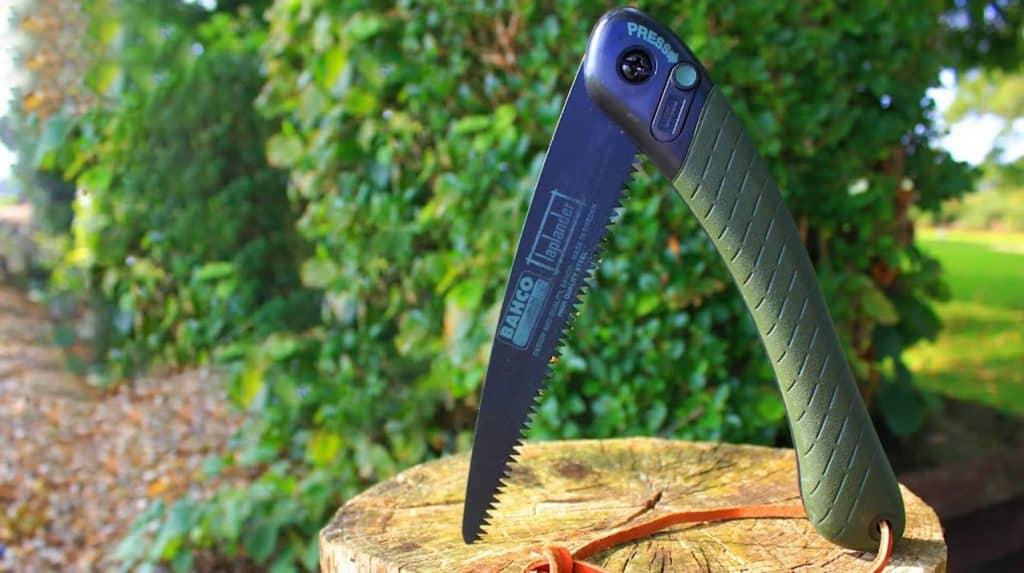
In the meanwhile, a folding camp saw is more efficient in its domain than a hatchet, a multi-tool, or a serrated survival knife and is practically indispensable for outdoor activities. Some time ago, I came across an old, and forgotten folding camp saw in a garage — it was an original proven model worth restoring, so the first thing I did was thoroughly cleansing and burnishing its handle and scraping rust off its surface. Then I proceeded to resharpen the teeth. I now have a solid, sharp, yet lightweight tool dealing with fuelwood far better than my backpacking hatchet. Now it helps me in almost any outside adventure, including camping, canoeing, trekking, and so on.
To sum it up, folding saw handles a lot of camp tasks like:
- Felling downed trees
- Clearing brush
- Processing fuelwood
- Building survival hideouts
- Other camping “go-to” options
Core Features Of A Solid Folding Saw Gear To Look For

Mind The Use Goals
While a pruning saw is intended to make thinner and more accurate cuts but can not cope with chunky logs, an ultra-compact backpacking saw is aimed at chopping tiny fuelwood meant for medium campfires and not for handling giant stacks of firewood. Thus, your work’s resulting efficiency is defined by your saw’s compatibility with the intended tasks and goals. If you can not decide on those yet and wish to apply them for a variety of scenarios, think of a verified “general use” folding saw model.
Weight
This is a primary factor defining a true “portable” camping saw. It fits easily, unfolds smoothly, and weighs not far more than a pencil— what else could I wish for, one may say. However, being easy to carry and lightweight is not that simple as it seems. This is when the notion of balance enters the game. And balance is the key player here. A lightweight saw is good at clearing brush, pruning, cutting wood so that you operate one-handed while the other hand holds the boughs. On the one hand, your arm muscles do not overtire, especially if you are working overhead. On the other, it is harder to control a saw which is too lightweight, and the precision and acuteness of such a saw are hardly optimal. In plus, it is easier to accidentally cut oneself with a thin-bladed saw, whereas the blade is more pliant and sometimes bends too easily.
Blade Design
A saw’s blade contributes much to the capacities of your saw. The blade’s shape and design, the amount and shape of the saw’s teeth — every feature is worth mentioning individually.
Blade Shape
Pruning saws are probably the most widespread ones meant for pruning trees. They own the blades with a concave shape so that their cutting edges provide and maintain better contact with the circular branch profile.
Contrary to drywall or metal folding saws having a straight sharp blade profile, a pruning saw surely will not deal with the edge of a workpiece that good.
The next saw type is a folding hand saw for carpentry designed with a convex blade shape. This particular blade form allows the tool to cut right into even surfaces such as the middle of a plywood sheet. So, it is always reasonable to keep in mind what material you are going to work with before casting various folding, mainly saw types.
Tooth Shape
Another helpful tip from us straightaway: apart from the overall blade design, it is important to examine your saw’s tooth shape: the shape of each tooth also identifies the style and performance of your folding saw. For example, teeth with a marked curved profile mean the saw will act more aggressively. Such teeth demand greater power and impulse to make a stroke but dig into the surface faster, whereas arborists saw teeth with a pyramidal shape shear the cut edges, leaving a surface clear.
NOTE: You can always tune flat V-shaped teeth of your folding hand saw for cutting in different ways, depending on which edge of the tooth is sharp.
Tooth Set (Kerf Width)
The saw’s kerf is basically the width of the trace it cuts through a certain material. The kerf is usually a bit wider than the blade itself — it is so thanks to the particular tooth set design (each tooth bent a little outwards). The more pronounced tooth set design — the more convenient your saw is in use and the more it prevents binding. Hence, use it as a hint when choosing a particular model: a wider kerf will cut a lot more timber per inch of cut depth but will hardly bind the way most saws with a smaller kerf do.
Teeth Count
Want to know what features are responsible for the smooth and quick performance of your saw? Have a close look at your saw’s teeth’ spacing as they are very related to this process. These spaces are measured in teeth per inch, or TPI. Therefore, a low TPI count of the blade makes the saw’s action more intrusive. Due to its bigger teeth and bigger spaces between the teeth (called gullets), it cleans up greater amounts of wood quicker. Such teeth per inch amount are optimal for a saw meant for firewood processing. However, it is far from being perfect when it comes to pruning trees in the garden as such a saw risks cutting them too roughly. Meanwhile, the blade with a high TPI amount will cut more slowly but more precisely without splintering and tearing much.
Mind that small gullets are easily clogged with wood chips, and cutting other materials like plastics or soft metals implies you have to clean them regularly.
Push vs. Pull Stroke
Saw blades may act in two different ways: some require pushing the saw away from yourself, while other saws’ teeth cut when you pull the saw to yourself. Pruning saws basically have an alternative setup involving triangular teeth cutting on both strokes, and this particular design lets a fine-toothed saw cut quicker. In terms of easy use, the saws acting on the pull stroke are a little more convenient and, consequently, a bit more popular.
Safety
This is absolutely a point not to disregard when seeking a fine folding hand saw.
Blade Lock Grip
It is by definition the folding locking mechanism of your saw that can cause most of the risks. The matter is that when you start working with the saw, your hand is in the path of the blade folding locking mechanism, and you have to watch the blade cautiously so that it does not fold closed on your hand and fingers. You surely know that this could lead to a horrible accident, but we still advise you to watch this instructional video on how to apply your saw safely.
In the above-mentioned episode, the man explains in detail the two safe methods of how to do it right on the example of a Bacho folding hand saw.
A model that is 100% safe owns a blade-locking feature when the blade is in an open position, and some items even have a dual lock providing extra safety in both the open and closed setups so you will never have to worry that the blade suddenly pops up or unfolds when working.
Top-Quality Gear
The blade design is also responsible for both the overall function of the saw and your safety; moreover, the blade steel quality, its material, and width influence the push-and-pull features mentioned above. If the saw with the push stroke has quite an inferior blade, it will likely snap if stuck in the cut, and you could simply cut yourself on a metal piece. A more solid blade and a bit more expensive will less likely bind (though it always depends on the cut) but surely will not snap.
Pay Attention To The Gear Guarantee
Among the manifold manufacturers, select those providing a lifetime warranty. Ensuring this proves the real confidence in what the company makes and implies that better materials were used when producing the saw. Moreover, if you register your saw after purchase and somehow it breaks over time, you could always have your money back or get your item replaced if needed.
Now, as you have gotten acquainted with a good portable saw’s several cardinal features, let’s proceed to our carefully curated list of the best folding saws the market offers today.
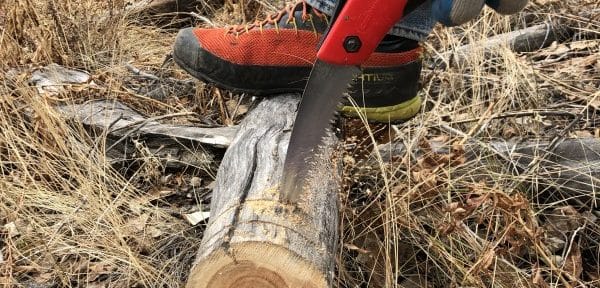
How To Sharpen Folding Hand Saw Properly
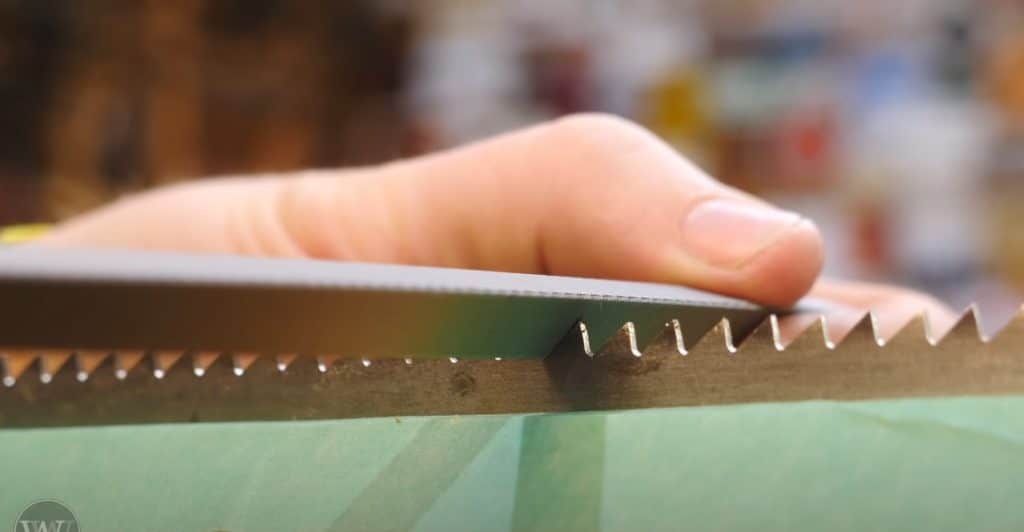
Sharpening saws is a crucial task, without a doubt. Firstly, it is better to do it regularly to prolong its life term and provide more accurate and cleaner cuts with less energy spent on the whole process. Secondly, your personal safety is affected, too, because such a utensil is easier to control, and it cuts much smoother when it is razor-sharp.
Following the next few steps, you will maintain your saw’s blade keen without extra effort and hassle.
First, get yourself a tiny diamond or triangle file matching the shape of your saw’s teeth right. To find the optimal size, it is better to go to the closest home utensils store or a garden shop and ask a professional seller’s advice.
The basic points are:
- Dismantle your tool and remove the saw’s blade.
- Wipe off the dirt, sawdust, and tree sap from your blade regularly. A stiff wire brush and a little water would be good helpers for this case. Stainless steel is preferable but if there are already some stains, use a solvent such as kerosene or isopropyl alcohol. When cleaning your tool, don’t forget about the gullets between the teeth.
- Make sure to rub each tooth, and keep in mind the number of strokes used on each tooth. Apparently, the less sharp your tool is, the more effort it takes.
- Check out its teeth length systematically. The tooth that stands out the most usually takes most of the effort and interferes with others when touching the surface.
- Though many saws are outward bent to get a bigger kerf width, it is advisable to check for teeth that are too bent. If they stand too far out of line, the overall handling may become harder. Try to bend them back but do not overbend them.
This video explains the mechanics of the sharpening action of the Silky pruning saws, but it works for most common models.
And do not hesitate to seek additional information, hints, and tips on great your tool like a PRO (or, if you please, a metate — a Japanese Master Sawyer).
Best Folding Saws Summary
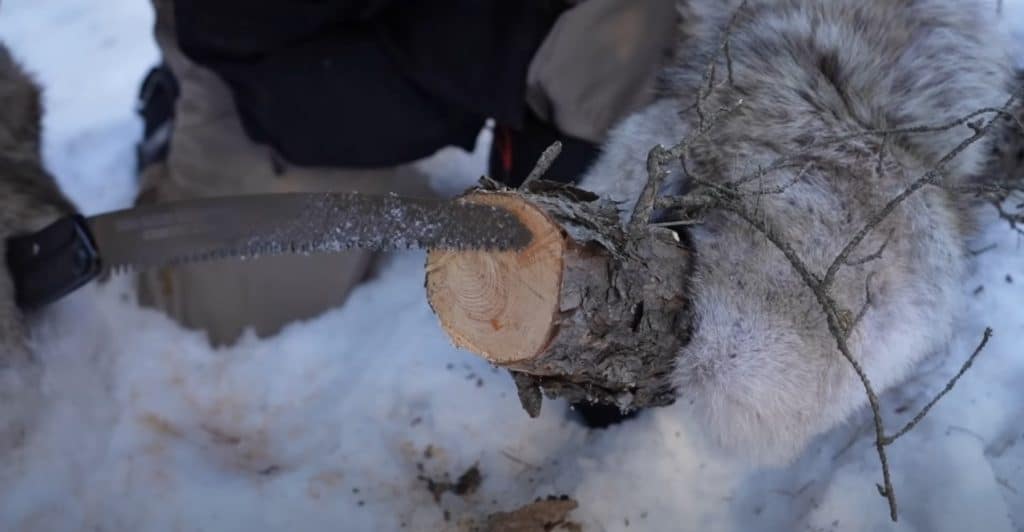
Being used to knives, axes, hatchets for years, we did not pay enough attention to hand saws, as it turned out to be. Hopefully, today we have provided enough arguments for buying one of the above-mentioned tools suited for everyone. What could be as compact, lightweight, and efficient as a model with a razor-sharp saw blade when it comes to pruning and gardening, butchering, yard work, chopping fuel wood, and other country chores?
And our last tip today, which always works whatever working tool you buy, is trying to seek a lifetime warranty for your product instead of relying on a shop’s guarantee. This way, the manufacturer shares the responsibility for its use as much as a reasonable customer does.
Frequently Asked Questions – FAQ
What is the best folding saw?
It always depends on your purposes and budget. Browse through our list of models and trust the renowned brands — for example, the Silky KATANABOY has the greatest reach and impressive efficiency when dealing with huge logs but maybe too expensive. In contrast, Silky POCKETBOY cuts smaller branches like butter and is less costly. Also, consider an item with a replaceable blade, such as any of the time-tested Coghlan Bow Saws (this saw comes with a set of blades), Gerber Freescape Camp Saws, or three-in-one compact saws like Mossy Oak. All of them have the chance to become the best folding saw for you.
What is the best hand saw for cutting trees?
Optimally, acquire the one with a solid and huge high carbon steel hard teeth blade, non-slip blade handle, and lifetime warranty (keep in mind that in that way, its size may be less compact). For instance, a heavy-duty saw like Edward Tools 7” Folding Saw or a REXBETI model is worth checking out in your case, and a Sven saw is worth considering, as well (such as Sven-Saw15″ Saw) as it has a fine reputation proven by multiple great reviews.
Length – what size for what job?
Blade lengths affect the overall performance greatly: use a finely-toothed, curved blade pruning saw for cutting smaller twigs up to 2.5 inches in diameter and doing other camping chores, while for bulkier logs, better take a longer blade with large, widely spaced teeth. For more accurate interior trim work, get a fine-toothed hand saw, while for bigger carpentry tasks, consider bigger jigsaws and table saws.
Which silky saw to buy?
Estimate the overall weight, size, and saws’ blade lengths for your particular purposes. We surely advise the above-mentioned models — the super-efficient and compact Silky Pocketboy 130, long-bladed Silky Katanaboy for impressive cutting performance. Apart from them, consider Silky Tsurugi 300-8, Silky Natanoko 2000, Silky Zübat Saw, and other worthy models.



